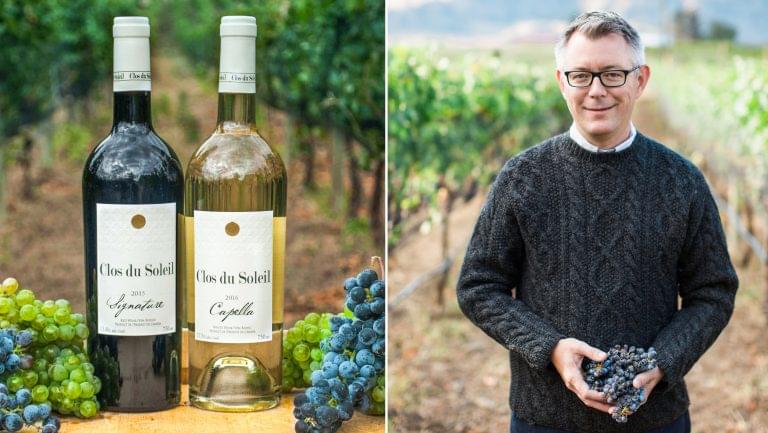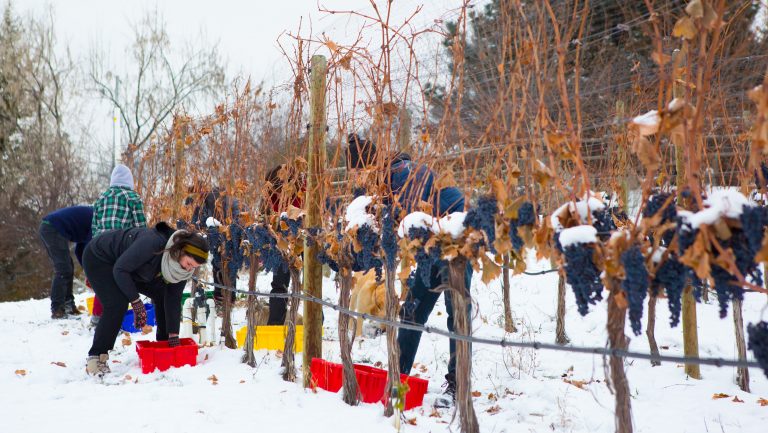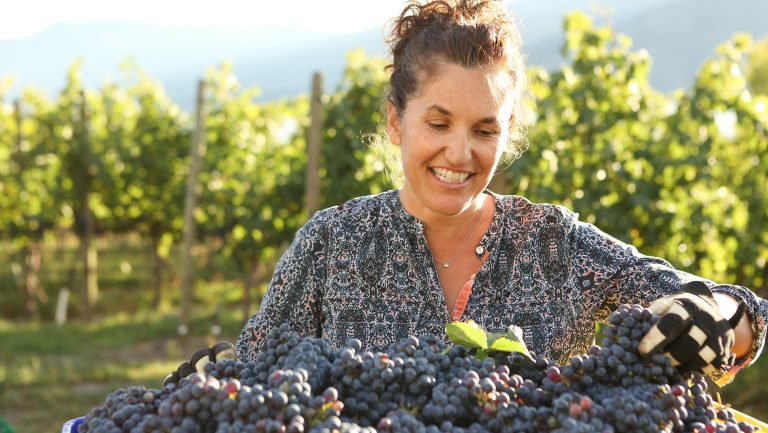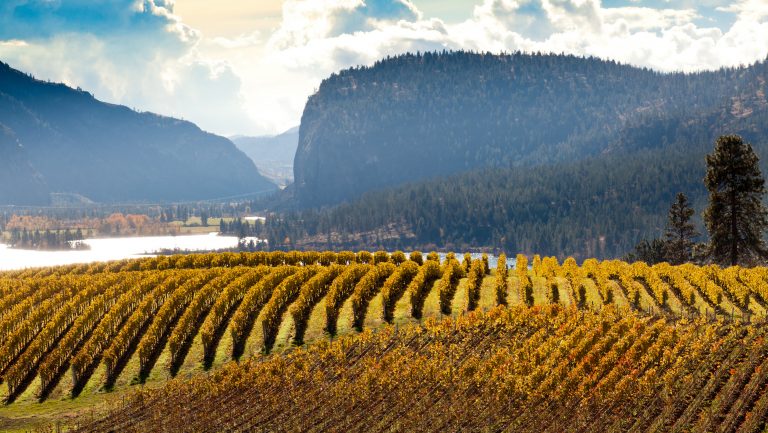As the wine buyer for one of Seattle’s top restaurants, Dahlia Lounge, if I want to put a wine on my list, I typically can, with few constraints. Some select wines are allocated or out of stock, but I can always easily find a reasonable alternative.
Yet after I visited the Okanagan Valley—the dominant wine region of British Columbia (B.C.), with around 84 percent of the province’s vineyards, according to the British Columbia Wine Institute (BCWI)—nearly three years ago, I was determined to get my hands on some of the great wines that are produced in this region that has more than 10,000 acres under vine, to no avail. I’ve had meetings with Canadian winemakers, American importers, and even the Canadian consulate, but there are still only a handful of B.C. wines available in the U.S. In the Seattle market, I can order more wine from Karnataka, India, which is approximately 8,000 miles away, than from Kelowna, British Columbia, which is just 190 miles away. What explains this disconnect—and why is it so difficult for U.S. buyers to source wines from this Canadian region?
Sparking Intrigue
My interest in the wines of British Columbia started over a decade ago, on a postgrad road trip to the Okanagan Valley with my father. Wine wasn’t the expressed purpose of the trip, but we did take the opportunity to visit a number of wineries in the southern Okanagan. I wasn’t nearly as wine savvy then as I am now, but the sheer fact that a wine industry was emerging in a country that most would assume was far too cold for viticulture was intriguing to me, even if the few bottles I brought home in 2006 were more curio than collectible.

Don’t miss the latest drinks industry news and insights. Sign up for our award-winning newsletters and get insider intel, resources, and trends delivered to your inbox every week.
That interest in Okanagan Valley wines mostly lay dormant until nearly a decade later, when a 2015 partnership between Whole Foods and a now-shuttered local importer—which brought B.C. wines to Portland, Oregon, and Seattle Whole Foods stores—landed me a seat at a promotional dinner featuring B.C. wines. After that dinner, I worked with the BCWI to create an itinerary for a trip to the region the following spring. Whether it was the electric Rieslings and Pinot Noirs of Tantalus Vineyards in Kelowna, the rich, complex, and extensively aged sparkling wines of Summerhill Pyramid in Kelowna, or the elegant yet structured Bordeaux-styled red wines of Clos du Soleil in the nearby Similkameen Valley, I found on that trip that the best wines in British Columbia did what many other wine regions promise but don’t always deliver—they balanced a New World sense of ripeness and generosity with the acidity, structure, and savory notes of the Old World.

It became clear after a few days on the trip that if I wanted to represent on my list at Dahlia the totality of the Pacific Northwest wine industry—which very much includes British Columbia—the vibrant wines of this region needed to be available in Seattle.
It started innocently enough, with a few conversations with winemakers like David Paterson of Tantalus Vineyards and Michael Clark of Clos du Soleil. They had experience making wine in places with thriving export markets, like New Zealand and Bordeaux, so they understood that for the wines of British Columbia to stand on the global stage, they couldn’t remain localized to Canada. These wines had to come to the United States as well, but the winemakers didn’t know how. “I don’t even know where to start with the U.S.,” says Valeria Tait, the general manager and winemaker of Bench 1775 in Penticton. “There’s no real knowledge in the region to export to America, and as far as I know, the BCWI doesn’t have resources to help.”
Naively, I thought it would be fairly easy. I knew that the B.C. wines I’d tasted could compare favorably and compete with their West Coast counterparts in terms of quality. The extreme latitude of British Columbia, around 49 degrees, creates a short yet intense growing season, while late September’s rapid cooling allows for later harvesting dates and longer hang times than most regions in Washington, Oregon, or California. This allows B.C. to make a huge range of wines, from Rieslings that are reminiscent of those made in the Finger Lakes, to fresh yet dark-fruited Pinot Noirs similar to those of the true Sonoma Coast, to Syrahs and Bordeaux varieties that can only be compared to high-elevation iterations from Washington and California.
I assumed that the main obstacle was a lack of exposure, so that’s what I set out to help with. I volunteered to sample a few Seattle-based importers and distributors on the wines, thinking that if they were as taken with them as I was, within a few months I’d be able to offer these wines on my list.
But while several importers were impressed with the wines, they seemed far less eager to actually import them. At first, I wondered if there were significant legal or logistical hurdles that they didn’t want to contend with, like heavy import duty difficulties in getting the wine across the border. I even looked into starting my own import business in order to get these wines to the U.S. before deciding that the startup costs were too high. It was this research that clued me in to the real obstacles preventing me—and other U.S. buyers—from getting B.C. wines.

B.C.’s Challenges
Two big things stand in the way of bringing wines from British Columbia to the U.S. The first is that no importer or distributor seems willing to truly pave the way. Building and establishing a market for B.C. wine in Washington State would undoubtedly require a certain amount of tenacity because consumer and trade perceptions of Canadian wine are fixed. “People around the world are just waking up to the potential of Canadian wine,” says Clos du Soleil’s Clark. “Most people see Canada as a place where you can’t grow grapes, or if you do, you grow them for ice wine.”
It’s on this front that both trade groups and the Canadian government have asserted themselves. The BCWI, which is a membership-based promotional organization for the province’s wineries, has arranged a number of tastings and trips to the region, including two trips that were organized for me in the last three years. Yet these promotional efforts are missing the mark with respect to what’s needed to garner attention and create demand for these wines in the U.S.
“Often when the BCWI promotes B.C. as a wine region,” says Erin James, the editor-in-chief of Sip Northwest magazine, “it’s as a travel destination, not as [a source of] wines to ask for in your favorite restaurant.” That mind-set needs to change if B.C. is going to develop a reputation as a notable wine region among consumers and wine professionals in the U.S.
Michael Wooff, the consul and senior trade commissioner at the Consulate General of Canada in Seattle, and his staff have also tried to find ways to host regular trade and media dinners stateside. But despite the attendance of dozens of wine buyers and media members, without much B.C. wine available in the marketplace, momentum tended to dissipate quickly.
The second obstacle, which has proven more intractable, requires some understanding of Canadian law. British Columbia in particular has had tariffs and laws in place for decades to protect the local wine industry, measures that have indeed achieved that goal. Because foreign wine is both harder to find and more expensive in B.C., the local wine has been strongly supported by the province’s residents. Given that production is still fairly limited in the region, most wineries are able to sell the majority of their wine through direct-to-consumer (DTC) sales. Because DTC sales tend to be more profitable for wineries, there is little motivation for B.C. wineries to sell through importers.
Those interested in entering the American market also had little understanding of how the three-tier system would result in significant markups for the consumer. “We’ve had exports from time to time to a variety of overseas markets,” explains Clark, whose wines should soon be available in Seattle through local importer and distributor H Wines, “but this is our first entry into the U.S. So far it has been pretty easy, but only because we’ve been directly working with one person. If I had to understand the three-tier system on my own, I’d be lost.”

Showing Progress
It’s not that no Canadian winemakers have tried. I recently added a Pinot Gris from Backyard Vineyards, the Langley-based winery, which sources fruit from around British Columbia, to my by-the-glass list at Dahlia Lounge. The wine’s importer, Brian Klassen, the president and owner of Klassen Wines & Craft Beer, a producer, importer, and broker based in Murphys, California, is himself a Canadian expat. He insists that the single biggest obstacle to getting B.C. wine into the U.S. is the wineries themselves. “The shipping, TTB [Alcohol and Tobacco Tax and Trade Bureau], and customs are all simple problems to solve,” he says. “The wineries have to be willing to [accept] less money for their wine, and so far they really haven’t been.”
Guy Harris, the owner of Cru Selections, an importer and distributor in Seattle, repeated that critique. “It has nothing to do with the border—we do that every day,” he says. “I’ve been trying to get B.C. wines for years.” Since Cru Selections was initially founded with a solely–Pacific Northwest portfolio, the company actively sought out B.C. wines but ran into challenges with pricing. “I don’t know if it’s just dumb luck,” says Harris, “but every winery I’ve looked into working with has wanted to charge me their retail cost as a wholesaler. That means that by the time we get [a wine] into the market, the consumer would end up paying double the retail cost in Canada, so what should be a $15 wine would be $30.”

There are signs, though, that change may be afoot. The BCWI’s most recent promotional dinner, held in Seattle in late June, showcased a wide range of producers and drew almost 70 attendees from the local trade and media. The event prompted Harris to again explore possibilities, while H Wines should soon have wines from both Clos du Soleil and Summerhill Pyramid in the market. The excitement was shared by both importers and distributors; Tait expressed enthusiasm about finding a market for her wines in Seattle. “That,” she said, “is why I’m here in the first place.”
The combination of world-class wine and a favorable exchange rate—for now, at least—might entice a few more American importers to take a chance on the region. That said, I’m not popping open my bottles of B.C. bubbly quite yet—because, for the moment, I’m still forced to drive them across the border myself.

Dispatch
Sign up for our award-winning newsletter
Don’t miss the latest drinks industry news and insights—delivered to your inbox every week.
Zach Geballe is the sommelier at Seattle’s iconic Dahlia Lounge, the flagship of Tom Douglas Restaurants. He is also the wine educator for the Tom Douglas group, a freelance wine and spirits writer, and the host of the wine-focused podcast Disgorged.







